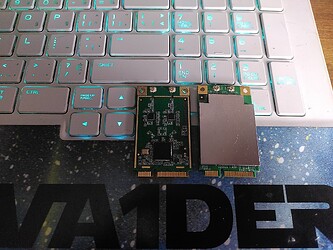Is it possible to shield this mPCIe wireless card to protect it from noise?
If yes, how?
Most interference (or noise) comes from other nearby APs as a result of co-channel or adjacent channel interference, or perhaps radar on a 5Ghz channel.
There's no way of shielding that since they're the very frequencies your radio needs to receive.
Yes, unfortunately I do have a lot of nearby access points. I used to believe that Wi-Fi instability was caused by a lack of shielding
Possible, yes - you see where the tin can was meant to be.
Reasonable, no - getting that to fit from scratch, without doing harm, is not going to be easy.
If it's properly built, the primary ingress of noise is only the antenna system.
So - simply connect the cables to the antenas, and enclose in a grounded metal case. Done.
(Usually devices/cases are built like that anyways - i.e. just properly install it.)
Ah yes! The device's case is metal. Now I'm %100 sure that the source of noise is nearby APs.
Thanks ![]()
If the card is the one pictured, then no, it's not properly built. That card is a UniElec MT7612. It is based on a design that MediaTek gave to UniElec, but UniElec skimped on its construction. The card is designed to have a shielding cage - you can see the exposed copper (what you see all along the edges) where that shielding cage was supposed to go, but UniElec didn't put one on. The UniElec card is pictured below beside a correctly shielded one:
On a shielded card, that is likely the case. With an unshielded one, no. As I said, I have this card and when I was testing it I noted that it was particularly noisy. When it's in the same case as the other card pictured, the UniElec card has a noise floor 12dB higher than the other one. Without a metal shell on the card, proximity to the rest of the electronics inside your device is a very significant source of noise. The CPU, PCI, DDR, and other bus clocks all operate in frequencies that can (espcially as they can heterodyne together) produce harmonics up to 5GHz.
That's interesting - surprising a vendor would even ship a card like that. It's asking for RMAs....
So did your DIY shielding work?
It's the reference design from MediaTek for the 7612. It's only intended as a development board, not for end users.
RMA isn't really an option with UniElec. They only market on Ali Express, AFAIK.
Sorry, no, I didn't build that shielding shown on the other card. That is a Mediatek card from another vendor that makes them correctly. I was just showing the difference.
To answer the original question (which I should have before), building a similar little cage is doable, but tricky. If I were to do it I'd likely use a .5mm or maybe .8mm copper sheet. Cut it to the right shape to fold, fold, and solder. Prior to soldering it I'd put dabs of hot glue on the card in various places to act as "spacers" to prevent the copper from contacting the board, since it wouldn't have the strength of the tin alloy used on the other card. For extra points, put a thermal pad on top of the MT7612 chip so the housing can act as a heatsink too. A 7612 doesn't generate all that much heat - IIRC, that card only puts out 17dBm or so of power, so the pad is more just a detail. The cage is only needed on one side - the other side is mostly backplane and doesn't need shielding.
It would be tricky to get right, though. For a UniElec 7612, I'm not sure it's worth the trouble or expense.
Wow, thank you for all the info.
I wasn't aware of the shielding at the time of purchase. Now I know that was a mistake.
I have a friend who runs an electronic store and I'll talk to him about that copper sheet solution.
0.3mm should do, and will be much more solderable than 0.5 or 0.8mm.
This topic was automatically closed 10 days after the last reply. New replies are no longer allowed.

